Welcome to my article How to Use Data Analytics to Fine-Tune Your Digital Marketing Strategy. In the world of digital marketing, data is the true superhero—faster than a speeding conversion rate, able to leap over customer behavior trends in a single bound. Okay, maybe it’s not quite that dramatic, but you get the point. Whether you’re running an eCommerce store, managing a brand’s online presence, or simply trying to grow your audience, data analytics is your best friend. It’s the secret sauce that turns gut-feelings into concrete decisions and random strategies into targeted campaigns that actually work.
Imagine trying to bake a cake without a recipe. Sure, you can guess the ingredients, but good luck getting it right. That’s what marketing without data is like. You can’t just guess your way through it anymore. Using data analytics, however, lets you get a clear picture of what’s working, what’s not, and where you should focus your energy. From tracking website traffic to understanding your customer’s every move, data empowers you to fine-tune your strategies for maximum impact. So, let’s break it down and look at how you can harness the power of data to make smarter decisions, increase conversions, and maybe even win a few marketing awards while you’re at it. Spoiler alert: data is that powerful.
Access My Proven Blueprint for $50-$100 Daily Income – Watch This FREE Video Now >>>

Understanding the Basics of Data Analytics in Digital Marketing
Before we dive into the world of dashboards, reports, and graphs (don’t worry, we’ll keep it fun), let’s take a step back and understand the very basics of data analytics in digital marketing. Simply put, data analytics is the process of examining raw data to uncover meaningful insights that can guide your marketing decisions. It’s like having a magnifying glass to inspect your marketing efforts—except, instead of a magnifying glass, you have algorithms and spreadsheets. Fancy, right?
Now, let’s talk about the types of data you’ll encounter in your digital marketing journey. First up, we have behavioral data, which tracks how your users interact with your website or app. This includes things like how long they stay, which pages they visit, and where they click. Next, there’s demographic data, which gives you a snapshot of who your audience is—age, gender, location, income, and even interests. Think of it as the personality profile of your ideal customer.
Then we have transactional data, which is exactly what it sounds like: any data related to purchases, subscriptions, or other actions where money changes hands. This is the bread and butter for eCommerce businesses and anyone looking to track ROI. Lastly, let’s not forget social media data—likes, shares, comments, and clicks from all your favorite platforms. This type of data tells you what’s resonating with your audience in the social sphere and what’s just…well, floating in the digital void.
The magic happens when you combine these different data points. When you analyze them, you’ll discover patterns, trends, and insights that will guide your marketing strategy. You’ll know what content performs best, where your traffic is coming from, and what steps need tweaking to improve performance. In other words, you can say goodbye to “guess and pray” marketing and hello to smart, data-driven decisions. So, grab that magnifying glass (or analytics tool) and start investigating your marketing strategy like a true detective. The answers are waiting!
Key Metrics to Track for Digital Marketing Success
Metrics—the numbers that separate the marketing pros from the marketing amateurs. If you’re not tracking the right ones, you might as well be throwing spaghetti at the wall and hoping it sticks. But don’t worry! With the right metrics, you’ll be able to pinpoint exactly what’s working (and what’s not) in your digital marketing strategy. Think of metrics as your compass, helping you navigate the often murky waters of the digital world. So, let’s break down the key metrics you absolutely need to be tracking if you want to see real success.
First up, traffic metrics. This is where the journey begins. If your website is a store, traffic metrics tell you how many people are walking through your doors (or clicking on your website). The most common traffic metrics include sessions, page views, and bounce rate. While page views are a great indicator of how much content your audience is consuming, the bounce rate tells you if your visitors are staying or leaving within a few seconds. A high bounce rate? That’s like someone walking into your store, glancing around, and then darting out the door. Time to reevaluate your content or landing page!
Next, we have conversion metrics, which are basically the “show me the money” part of digital marketing. These include things like conversion rate, cost per conversion, and lead generation. Conversion rate is the golden child of digital marketing. It’s the percentage of visitors who actually complete a desired action, like signing up for your newsletter or making a purchase. If your conversion rate is low, it’s time to investigate whether your call-to-action (CTA) is clear or your checkout process is a nightmare. You can tweak these factors and watch your conversions climb.
Then there’s engagement metrics, the heart and soul of social media marketing. These are the likes, comments, shares, and click-through rates (CTR) on your emails and ads. They tell you how much your audience is interacting with your content and, most importantly, whether it’s resonating. A high engagement rate on a post or campaign? That’s a sign that you’re speaking directly to your audience’s heart (or, you know, their wallet).
Finally, we have revenue and ROI metrics, because what good is all that traffic and engagement if it doesn’t turn into money? Return on investment (ROI) is the king of all metrics. It tells you how much profit you’re making in comparison to how much you’re spending. Are your ads paying off? Are your content strategies driving sales? These numbers tell you whether your marketing budget is being well spent—or if it’s time to trim the fat.
By tracking these key metrics, you’re not just flying blind. You’re making informed decisions, tweaking strategies based on data, and ultimately improving the performance of your digital marketing campaigns. It’s like having a GPS for your marketing journey—without it, you’re just wandering around hoping for the best. So, get tracking!
Using Google Analytics for Deeper Insights
Google Analytics—your trusty sidekick in the world of digital marketing. It’s like a superpower that helps you understand exactly how visitors behave on your site, where they come from, and what they’re doing once they get there. If you’re not using it yet, it’s like having a Ferrari and never stepping on the gas. So, let’s break down how you can use Google Analytics to get the deep, meaningful insights that will help you fine-tune your digital marketing strategy and drive more conversions.
Access My Proven Blueprint for $50-$100 Daily Income – Watch This FREE Video Now >>>
First, let’s talk about setting it up. If you haven’t done it yet, don’t worry, it’s not as complicated as assembling IKEA furniture (though, depending on the level of your website, it might feel close). Just install the tracking code on your website, and boom—you’ve got access to a treasure trove of data. But to really get the most out of Google Analytics, you’ll need to know which reports to focus on. It’s like shopping for groceries—you don’t want to wander the aisles aimlessly, hoping you’ll find something useful. Instead, head straight to the key sections that matter.
One of the most important reports to check out is the Audience Overview. This gives you a snapshot of who’s visiting your site—how many people, where they’re coming from, what devices they’re using, and how long they’re sticking around. It’s like being able to peek into the minds of your visitors (in a totally non-creepy way). Are you attracting the right crowd? If your traffic is mostly from locations you’re not targeting, or you’re seeing a high bounce rate on mobile, that’s a red flag to reassess your strategy.
Next, dive into the Acquisition report, which tells you how people are finding you. Are they coming from search engines, social media, or paid ads? This is where the magic of digital marketing happens. You might discover that your social media campaigns are getting a lot of clicks but aren’t leading to conversions, or that organic traffic from SEO is doing better than paid ads. This insight allows you to shift resources to the channels that are really working for you.
Then, don’t forget to check out the Behavior Flow report. This one is a goldmine for understanding how users navigate through your site. It shows you the journey your visitors take, from landing page to exit. Are they getting lost after reading your blog post? Or are they happily hopping from one product page to the next before checking out? If people are leaving at certain points, it’s time to improve those pages to keep them engaged.
Finally, there’s Goals and Conversions. This is where you track whether all those people you’re attracting are actually doing what you want them to do—signing up for your email list, purchasing your products, or filling out contact forms. Set up specific goals to track, and watch the data come in. If your conversion rates are lower than expected, you might need to tweak your CTAs, simplify your forms, or optimize your checkout process. Google Analytics isn’t just for monitoring traffic; it’s the ultimate tool for refining your sales funnel.
In short, Google Analytics is like having a supercharged magnifying glass on your marketing performance. It lets you spot the tiniest details—like which pages need a little TLC, or which marketing channels are killing it. By consistently reviewing the right reports, you can make smarter decisions, adjust strategies on the fly, and ultimately, boost your digital marketing results. So, dust off that Google Analytics dashboard, dive deep into the data, and start turning those insights into action!
Leveraging A/B Testing to Optimize Marketing Campaigns
A/B testing—sounds fancy, doesn’t it? But don’t let the name fool you. It’s basically a simple way to test out two different versions of something and see which one performs better. Think of it like trying two different pizza toppings and seeing which one gets devoured first—only instead of pizza, you’re testing headlines, calls-to-action, images, or even entire landing pages. And instead of your friends’ taste buds, you’ve got your audience’s preferences in the driver’s seat. It’s the marketing world’s answer to trial and error, but way smarter.
So, how does A/B testing actually work in a marketing campaign? Let’s break it down. Say you’re running a paid ad campaign or sending out a newsletter. You’ve got two options—maybe two different subject lines or a different layout for your email. With A/B testing, you create both versions (let’s call them “A” and “B”) and send them out to a portion of your audience. Half your audience gets version A, and the other half gets version B. From there, you sit back, grab your coffee, and wait for the results to roll in. The goal? Find out which version leads to more clicks, sign-ups, or purchases. It’s all about data-driven decisions, not gut feelings or hoping your instincts are spot-on.
Here’s the thing: A/B testing isn’t just about testing whether a red button or a green button gets more clicks (though it totally can). It’s about optimizing every aspect of your digital marketing strategy. Want to know which type of email subject line gets the most opens? Test it. Wondering if a bold image will boost your conversion rates? Test it. Unsure if your landing page copy is hitting the right note with your audience? Yep, you guessed it—test it. A/B testing allows you to experiment with small tweaks that can have big impacts, one test at a time.
Now, it’s important to do it right. If you’re testing a subject line, for example, make sure that’s the only difference between the two versions. If you change too many variables at once (like the subject line, layout, and image all in one go), you won’t know which element is driving the success. A/B testing is about isolating one factor at a time to see what truly moves the needle.
The beauty of A/B testing is that it helps you optimize your marketing campaigns in real time. You don’t have to make guesses or rely on broad assumptions anymore. With real-world data, you can continually refine your content, design, and strategy to get the best possible results. It’s like tuning a guitar until it hits that sweet spot—each small adjustment brings you closer to perfection.
So, if you haven’t yet embraced the power of A/B testing, now’s the time to start. Whether you’re working on improving email open rates, boosting click-through rates on ads, or tweaking your website’s design for higher conversions, A/B testing is your secret weapon. Don’t just hope things are working—find out for sure! And remember, every time you test, you’re one step closer to marketing greatness.
Tools and Technologies to Enhance Data Analytics
Alright, so you’re hooked on data analytics—great! Now, how do you take your data game to the next level? That’s where the right tools and technologies come in. Think of them like the high-tech gadgets in a spy movie, helping you gather intel, analyze it, and make decisions faster than you can say “James Bond.” With the right tools, you’ll have the power to extract deep insights, predict trends, and optimize your digital marketing strategy with the precision of a master strategist. Let’s take a look at some of the coolest tools out there that will supercharge your data analytics efforts.
First up, Google Analytics—the heavy hitter in the world of analytics tools. If you’re not already using it, you’re missing out. It’s like the Swiss Army knife of digital analytics, offering a wide range of features to track user behavior, monitor traffic, and measure conversion rates. But don’t just settle for the basics. Dive deep into custom reports, set up goals and events, and make use of its real-time data tracking to adjust your campaigns on the fly. With Google Analytics, you can track everything from the number of visitors on your site to which blog post had your audience reaching for the “share” button.
Next, let’s talk about SEMrush—your best friend when it comes to competitor research and SEO performance. SEMrush is more than just an SEO tool; it’s a powerful analytics platform that helps you track your website’s performance, find profitable keywords, and even uncover what your competitors are up to. By analyzing competitors’ organic and paid search strategies, you can adjust your approach accordingly and stay ahead of the curve. It’s like having a crystal ball, only a bit more grounded in data and a lot less mystical.
Then, we’ve got Hotjar—a tool that lets you literally watch your users’ behavior. With heatmaps, session recordings, and surveys, Hotjar shows you where visitors are clicking, how far they’re scrolling, and where they’re getting stuck on your site. Imagine being able to see exactly where your customers’ attention is focused and where they’re dropping off. It’s like watching a movie, except the plot is all about how your audience interacts with your website. These insights allow you to optimize user experience, reduce bounce rates, and guide visitors through a more seamless journey toward conversion.
For those looking to get even more technical, Tableau is your go-to for advanced data visualization. It’s like taking a boring spreadsheet and transforming it into a visually appealing dashboard of insights. With Tableau, you can connect to a variety of data sources (Google Analytics, social media platforms, and more) and create custom visual reports that help you spot trends, track performance, and uncover opportunities for optimization. It’s perfect for marketers who want to make data-driven decisions but don’t want to get lost in the weeds of raw numbers. If you’ve ever wanted to turn a mountain of data into a clear, actionable picture, Tableau’s the tool to do it.
Lastly, Power BI, Microsoft’s data analytics tool, is a solid option for those who want to create stunning, shareable reports that combine data from multiple sources. Power BI’s interactive dashboards are perfect for visualizing your KPIs, customer behavior, and trends. Whether you’re looking at sales, traffic, or customer demographics, Power BI turns complex datasets into easy-to-read visuals that make sharing insights with your team a breeze. It’s the analytics version of a well-organized filing cabinet—everything in its place and easy to access.
Using the right tools and technologies isn’t just about gathering data; it’s about making your data work for you. The more you understand your audience’s behavior, the better equipped you’ll be to make decisions that optimize your marketing efforts. These tools help you extract actionable insights from your data, which means fewer gut-feeling guesses and more data-driven success. So, whether you’re tweaking your content strategy or refining your ads, these tools are your secret weapon in becoming a data-driven marketing master. Get them on your side, and watch your digital strategy reach new heights!
Conclusion
And there you have it—data analytics isn’t just for the tech geeks and number crunchers anymore! By harnessing the power of the right tools and technologies, you can turn your digital marketing strategy from a guessing game into a precision-targeted missile. Whether it’s tracking key metrics, running A/B tests, or using sophisticated platforms like Google Analytics, SEMrush, or Hotjar, every step you take is bringing you closer to becoming a data-driven marketing mastermind. It’s like upgrading from a bike to a Ferrari—you’ll zoom past your competition while leaving them eating your digital dust.
Access My Proven Blueprint for $50-$100 Daily Income – Watch This FREE Video Now >>>
But remember, data analytics isn’t a one-time thing; it’s an ongoing journey. The digital landscape is constantly evolving, and so should your strategy. Just like a seasoned chef tweaks a recipe to perfection, you’ll need to continually test, analyze, and refine your campaigns. Data isn’t static, and neither should your marketing tactics be. The best part? Every new insight you uncover will help you fine-tune your approach, giving you a competitive edge and ultimately helping you connect with your audience in a more meaningful way. It’s all about making smarter decisions, and with these tools in your digital toolbox, you’re well on your way.
So, if you’ve been on the fence about diving into the world of data analytics—now’s the time. With a little curiosity and the right tools, you’ll be amazed at the insights you can uncover and the improvements you can make. No more relying on gut feelings or outdated strategies. It’s all about actionable data, and trust me, the results speak for themselves. Now, go ahead, fine-tune that strategy and get ready to see your marketing efforts soar!
Thanks a lot for reading my article on “How to Use Data Analytics to Fine-Tune Your Digital Marketing Strategy“ till the end. Hope you’ve helped. See you with another article.










